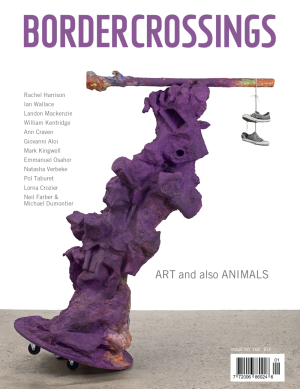“Never Trust a Hippie” by Barb Hunt
One of the good things about Never Trust a Hippie is that it forces viewers to declare themselves. I think to write this review I will have to straightaway declare my age. I was born in 1963. I’m a member of the generation that simultaneously envies the youth of the sixties for their sense of belief and identity (and grooviness, I suppose), and resents them for leaving us with a failed revolution and the resulting cynicism and chaos.
The sixties have been parodied, pastiched, and sentimentalized; in 1987 it’s about time the decade was historified. Barb Hunt’s work isn’t history; it’s more a curative dose of anti-nostalgia. As such it represents a step towards examining the sixties through something besides rose-coloured granny-glasses.
The exhibition is made up of seven, very large, multi-media sculptures and seven corresponding books. It might seem that such a small number of large-scale pieces linked by theme would make up a coherent, “big impact” show, but Hunt’s work is surprisingly and wackily detailed. As well, I think it is deliberately jarring and uneven. The term, “multi-media,” might have been coined just for her. Her list of materials includes netting, plastic bugs, old John Lennon tapes, leather things, propellors, and lots of objects that look like they came as prizes in cereal boxes. Some of the pieces have a rigorous formed beauty—”Druggie” and “Art Teacher,” for example. Others display the deliberate ugliness, the amateurish “realistic” drawing, and the hokeyness and camp often seen in New Image work. It’s a strange mixture, and viewing Never Trust a Hippie is a lot like poking around in an old attic, coming on delicate treasures as well as old animal skeletons.
Barb Hunt’s argument, though, is very consistent. She makes it clear through her images and texts that to her the sixties was a revolution of mostly young, white, middle-class males, those who could afford the luxury of grooviness. Hunt is concerned that sixties youth tried a short-cut to utopia—rejecting material and communal reform in favour of idealistic and individualistic revolution (change your head, change the universe).

Social Worker, 1986, Barb Hunt, mixed media, 270 x 150 cm.
Hunt uses seven bitterly satirical character sketches as vehicles for her view. (Her arguments are very specific; this tends to diffuse the visual immediacy of the works as it increases their intellectual complexity. Perhaps this is an unresolvable dilemma in the new strain of highly political post-modernist work.) “Guru” depicts a hippie who has picked up enough eastern religion to give him spiritual self-righteousness without letting Zen self-denial interfere with dope or money. “Druggie” is about the nihilism and internalism of drug use—a counter to sixties romanticism about the liberating and radical force of drugs. “Martyr” is a harsh look at the communal movement, suggesting that when some hippies went back to the land, they also went back to prehistorical sex roles. Nostalgic primitivism and mystical notions of fertility came down hardest on women. “Art Teacher” is a beautiful but threatening piece: geometric, hard-edged, nailed and rivetted. It is a symbol of the aggressive masculinity of the sixties art scene, a scene that, for Hunt, defined art as a virile, even ejaculatory, and individualistic force ravaging the effeminate, frigid body of society.
Hunt goes after the discrepancy between appearance and reality in the sixties. The fronts of her works are often about peace, love and understanding. But the backs are different. They show ugly skeletons, torn and twisted rags, or the banal pictures of “True Love Romance” comic books. The two-dimensional constructions are propped up or tied together, deliberately jerry-rigged. Hunt gives a sense that the images of the sixties are flimsy and flat.
This notion is underscored in the books, which often contain extended chunks of documents as well as Hunt’s own jotted thoughts. The book on the piece “Ex,” for example, exposes class hypocrisy: Hunt writes of the middle-class kid choosing to be “temporarily poor…rebelling against the establishment. ..with his old man’s money.”
Hunt’s books are evidence of her desire to communicate rather than to mystify, to explain the creative process rather than to conceal it, to be self-referential and self-critical. However, this quantity of information can start the viewer on an ever-decreasing circle toward a fixed point of meaning. Sometimes the books are open-ended and provoking; at other times, they answer questions when they should be posing them. (Perhaps, as a critic, I’m just nervous about the shaking up of roles. It used to be that art was expression and criticism was analysis. Now artists can be as verbal and analytical as critics.)
One viewer wrote in the guest book that Hunt had “missed the point of the decade.” Hunt is bitter, but it is bitterness tempered with wit and lightened by the obvious joy she takes in construction. I don’t think she intends to be fair to the sixties, and fairness isn’t always necessary in art. Hunt shows us what the sixties weren’t; maybe that allows us to see more clearly what they were. After all, that difficult decade gave us freedom; it would only take an equally vitriolic look at the fifties—the unabashed consumerism of the dinette set, the restrictive femininity of the New Look—to remind us of that potent fact. ♦
Alison Gillmor is a regular visual arts reviewer for Border Crossings.

